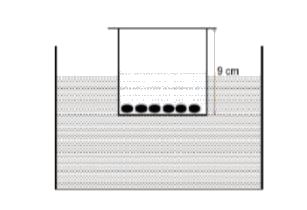The surface of a planet is found to be uniformly charged. When a particle of mass m and no charge is thrown at an angle from the surface of the planet, it has a parabolic trajectory as in projectile motion with horizontal range L. A particle of mass m and charge q, with the same initial conditions has a range L/2. The range of particle of mass m and charge 2q with the same initial conditions is-
L
L/2
L/3
L/4
Step by step video & image solution for The surface of a planet is found to be uniformly charged. When a particle of mass m and no charge is thrown at an angle from the surface of the planet, it has a parabolic trajectory as in projectile motion with horizontal range L. A particle of mass m and charge q, with the same initial conditions has a range L/2. The range of particle of mass m and charge 2q with the same initial conditions is- by Physics experts to help you in doubts & scoring excellent marks in Class 12 exams.
Topper's Solved these Questions
Similar Questions
A wide bottom cylindrical massless plastic container of height 9 cm has 40 identical coins inside it and is floating on water with 3 cm inside the water. If we start putting more of such coins on its lid. It is observed that after N coins are put, its equilibrium changes from stable to unstable. Equilibrium in floating is stable if the geometric center of the submerged portion is above the center of mass of the object) The value of N is closed to
 06:23View Solution
06:23View SolutionA charged particle of mass m=1 kg and charge q=2muC is thrown for a horizotal ground at an angle theta=45^@ with speed 20 m//s . In space a horizontal electric field E=2xx10^(7) V/m exist. Find the range on horizontal ground of the projectile thrown.
03:13View SolutionA particle A of mass m and charge Q moves directly towards a fixed particle B , which has charge Q . The speed of A is a v when it is far away from B . The minimum separtion between the particles is not proportional to
04:04View SolutionA particle of mass m and charge q is thrown in a region where uniform gravitational field and electric field are present. The path of particle:
06:03View SolutionA particle of mass m and charge q is thrown with initial velocity v_(0) at an angle with the horizontal. In space there exist an electric field of strength E at angle beta with the downward vertical away from the point of projection. Find the time of flight and range of projectile on horizontal ground
03:03View SolutionA spherical planet far out in space has mass 2M and radius a. A particle of mass m is falling freely near its surface. What will be the acceleration of that particle ?
04:01View Solutionकिसी आवेशित कण का द्रवमान m तथा इस पर आवेश q हैं । कण को V विभवान्तर से त्वरित करने पर सम्बन्ध दी-ब्रोग्ली तरंगदैर्ध्य का सूत्र ज्ञात कीजिए ।
05:33View Solutionद्रव्यमान m, आवेश q तथा वेग v का एक अल्फा कण आवेश Q तथा द्रव्यमान M के एक नाभिक पर आपतित होता है | निकटतम पहुँच की दुरी होगी :
View SolutionA particle of charge q , mass m and energy E has De-Broglie wavelength λ , For a particle of charge 2q, mass 2 m and energy 2E, the de-Broglie wavelength is
02:50View Solutionएक गोलीय ग्रह का द्रव्यमान M तथा व्यास D है । इसके पृष्ठ पर स्वतंत्रतापूर्वक गिरते हुए m द्रव्यमान के कण के लिए गुरुत्वीय त्वरण का मान होगा -
03:13View Solutionसुदूर अंतरिक्ष में स्थित एक गोलाकार ग्रह का द्रव्यमान M तथा व्यास d में है । m द्रव्यमान का एक कण इस ग्रह की सतह के निकट से स्वतंत्रतापूर्वक गिर रहा है । इस कण का गुरुत्वीय त्वरण अनुक्रमानुपाती होगा-
04:02View SolutionA particle is projected from the surface of the earth with a speed of 20 m* s^(-1) at an angle 30^@ with the horizontal . The range of that particle is
04:33View SolutionA charged particle of mass m and charge q is kept initially at rest on a frictionless surface. Another charged particle of mass 4m and charge 2q starts moving with velocity v towards it. Calculate the distance of the closest approach for both the charged particles.
03:48View Solutionm द्रव्यमान एवं आवेश q के कण को क्षेत्र में फेका जाता है जहाँ समरूप गुरूत्वाकर्षण क्षेत्र एवं विद्युत क्षेत्र विद्यमान है। कण का पथ।
03:37View SolutionA charged particle of mass m=1 kg and charge q=2muC is thrown for a horizotal ground at an angle theta=45^@ with speed 20 m//s . In space a horizontal electric field E=2xx10^(7) V/m exist. Find the range on horizontal ground of the projectile thrown.
02:15View Solution

